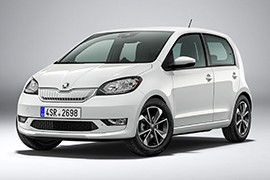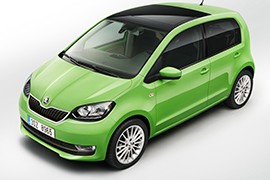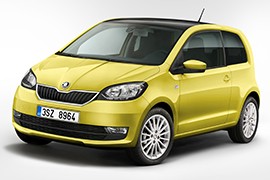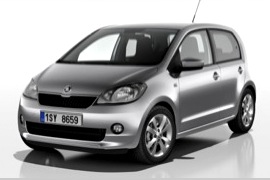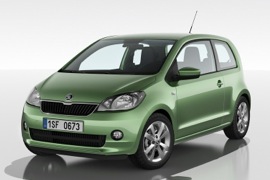SKODA Citigo Models/Series Timeline, Specifications & Photos
First production year: 2011
Engines: Electric, Gasoline, Natural gas
Body style: Hatchback
The electric-car frenzy made the Czech car-manufacturer to build the 2019 Citigo small-car model as a full-electric model with a big autonomy, enough to roam around town.
The need for electric vehicles was high and car-manufacturers around the world started to offer various vehicles. The Volkswagen Group offered a small electric vehicle lineup with three badges: Seat Me, Volkswagen UP!, and Skoda Citigo iV. Basically, the three vehicles shared the same assembly line, and it was only a badge-engineering. In the end, it was all about styling and pricing.
The Skoda Citigo iV was the most affordable of all three models and it has its own style and specific design to attract its customers. Since it didn't have an internal combustion engine under the hood, it didn't need an actual grille. The Skoda's designers chose to install the 21 vertical bars on a frame to mimic a grille. That pattern was also used for other cars in the lineup. The Citigo iV was fitted as standard with 14" steel wheels, on the Ambition trim level. For the Style trim level, 16" light-alloy wheels were offered as standard.
Inside, the car was fitted with minimum requirements for a car that goes around town for the daily commute. There were some specific options such as infotainment system, parking sensors, insulated windows, or heated front seats.
For the drivetrain, the Citigo iV featured an electric motor on the front and a battery in the floor. It consisted of a total of 186 cells and allowed a range of a maximum of 265 km (160 miles). It had the ability to be driven as a single pedal drive.
Based on the same platform as its sibling, the Volkswagen up! And the SEAT Mii, the 2017 Citigo was Skoda's alternative for urban mobility, with a five-door hatchback that could fit in most parking lots inside the busiest European cities.
While it was mostly a badge-engineered product, the car retained the Czech brand image identity. Its cubist styling was already notorious for Skoda, and the automaker promised that the running costs for the car won't ruin anybody. In addition, its price made it very interesting not just for pizza delivery but also for those who didn't or couldn't spend too much for a family vehicle.
On the outside, the most significant upgrade was visible on the headlights, which boasted LED daytime running lights. In addition, the wide headlights swept back on the sides created the image of a larger vehicle. From its profile, it was noticeable that the front doors were shorter than on the three-door version of the Citigo.
Thanks to its five-door configuration, the Citigo could easily accommodate four adults inside for short trips within the city. Still, the slim seats couldn't provide enough comfort for long distances. At the front, Skoda installed power windows and an AC unit, while the occupants from the split-fold bench seat in the back had to deal with the pop-out windows system installed on the rear doors. A removable navigation system was available as an option, and it could have been mounted on a special cradle on top of the center stack.
Underneath the hood, Skoda installed an inline-three engine available in two power versions paired with a five-speed manual gearbox or a five-speed automatic, depending on the option.
As the name says, the Citigo was designed as a city car that would be practical, good looking and easy on the pocket.
2 engine options were available with the new Citigo, both being a 1.0-liter gasoline. The power ranged between 59 hp and 74 hp.
While the 59 hp version was a good choice for city-only driving, the stronger acceleration of the more powerful 74 hp engine would allow the driver to get out of the city. Of course, it would not provide the smooth ride of a sedan, due to the wind noise noticeable at higher speeds.
A 5-speed manual transmission was standard for both engines, however, an automatic gearbox was optional.
The Citigo had a good suspension and offered a comfortable ride. For the models with a sportier suspension, the quality of the ride would be a little compromised.
Overall, the Citigo was a stable car and easy to control.
Although a small car, the cabin looked and felt airy. As it was built to a budgets, lots of hard plastics were used throughout, but they still looked good with the contrasting colors available.
The small Citigo had a height-only adjustable steering wheel.
Connectivity wise, Skoda chose a Garmin touchscreen display that would control most of the infotainment system. Looking like more of a traditional sat-nav system, the touchscreen display was detachable.
An USB port was also available, along with a standard 12V socket.
The Citigo was surprisingly spacious in the front, and the storage space offered was relatively good, with cupholders, a small shelf and a decent size glovebox.
While most of the rivals on the market would offer seating for 3 in the back, the Citigo could only accommodate 2 people. Legroom was limited and the access inside was a bit difficult for the 3-door model.
Every version of the Citigo came with rear folding seats to extend the trunk size if necessary.
Overall, the Citigo was cheaper than most of its competitors and still offered good features, low running costs, comfort and it didn’t look bad either.
The mini segment was very important in Europe, where narrow streets and sharp curves are almost in every city. This is why Skoda, a member of the Volkswagen Group, joined the game with the little Citigo in both 3 and 5 doors.
It was built on the same platform with Seat Mii and Volkswagen up!, on the NSF platform (New Small Family). Basically, most of the car was the same as the other two from the group. It had a different hood, headlights, and slightly different rear tailgate and taillights. But al three of them were produced in the same factory.
Inside, there are some large metal parts exposed, like in a 1980's car, but if someone needs an umbrella on wheels the Citigo was a good option. The car featured a removable navigation system, that could have been plugged on top of the dashboard. And, due to its incorporated battery pack, it could be used outside the vehicle for a walk to the destination. The instrument cluster had three dials. A large speedometer, a fuel level, and the coolant temperature. The tachometer was removed due to a lack of space. In the rear, the access was easy thanks to the wide opening of the doors. The rear windows were on hinges on the front side and could have been opened a little bit outwards. There was enough room for two adults and enough trunk space to carry a few pizza boxes.
Under the hood, it came with a small, 1.0-liter engine in two power options. It was available with a manual or automatic gearbox.
The mini segment was very important in Europe, where narrow streets and sharp curves are almost in every city. This is why Skoda, a member of the Volkswagen Group, joined the game with the little 3-door Citigo.
It was built on the same platform with Seat Mii and Volkswagen up!, on the NSF platform (New Small Family). Basically, most of the car was the same as the other two from the group. It had a different hood, headlights, and slightly different rear tailgate and taillights. But al three of them were produced in the same factory.
Inside, there are some large metal parts exposed, like in a 1980's car, but if someone needs an umbrella on wheels the Citigo was a good option. The car featured a removable navigation system, that could have been plugged on top of the dashboard. And, due to its incorporated battery pack, it could be used outside the vehicle for a walk to the destination. The instrument cluster had three dials. A large speedometer, a fuel level, and the coolant temperature. The tachometer was removed due to a lack of space. In the rear, there was enough room for two adults and enough trunk space to carry a few pizza boxes.
Under the hood, it came with a small, 1.0-liter engine that didn't have too much power but it was very fuel-efficient.
